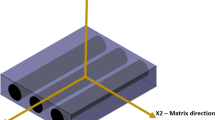Abstract
When considering materials for load-bearing applications, designers are increasingly examining the advantages of using plastics materials, both thermosets and thermoplastics, instead of traditionally accepted materials and, in particular, metals. Thermoplastics have three main advantages, their low specific gravities, their low energy requirements for manufacture and their low costs of fabrication, particularly by the injection moulding route.
Access this chapter
Tax calculation will be finalised at checkout
Purchases are for personal use only
Preview
Unable to display preview. Download preview PDF.
Similar content being viewed by others
References
Tennant, R. M., Science Data Book, Oliver and Boyd, Edinburgh, 1971
Brydson, J. A., Plastics Materials, Newnes Butterworth, London, 1975.
Sheldon, R. P., Composite Polymeric Materials, Applied Science Publishers, London and New York, 1982, Ch. 1.
Udel Polysulphone, Union Carbide (UK) Ltd, Rickmansworth, UK, 1983.
Victrex Polyethersulphone, ICI PLC, Welwyn Garden City, UK, 1982
Victrex Poly-ether-ether Ketone, ICI PLC, Welwyn Garden City, UK, 1980.
Deroton Polyester Moulding Compounds, ICI PLC, Welwyn Garden City, UK, 1983.
Vespel Polyimide, DuPont (UK) Ltd, Hemel Hempstead, UK, 1984.
Pye, A M, Materials in Engng April 1982, 3, 407–9.
Smith, C. P., ICI PLC, Wilton, private communication.
Noryl Thermoplastics Resins, General Electric Plastics BV, Bergen Op Zoom, The Netherlands, 1981.
Hearle, J. W. S., Polymers and Their Properties, Vol. 1, Ellis Horwood, Chichester, UK, 1982.
Mascia, L., Thermoplastics: Engineering Materials, Applied Science Publishers, London and New York, 1982.
Robeson, L. M., Noshay, A, Matzner, M. and Merriam, C. N., Die Angew Mak. Chem., 1973, 29 /30, 47–62.
Noshay, A., Matzner, M., Barth, B. P. and Walton, R. K, Amer. Chem. Soc. Div. Org. Coatings, Plast. Chem. Preprint, Sept. 1974, 217.
Agarwal, B. D. and Broutman, L. J., Analysis and Performance of Fibre Composites, John Wiley and Sons, New York, 1980.
Piggott, M. R., Load-bearing Fibre Composites, Pergamon Press, Oxford, 1980.
Pritchard, G. (Ed.), Developments in Reinforced Plastics — 1, Applied Science Publishers, London and New York, 1980.
Hancox, N. L. (Ed.), Fibre Composite Hybrid Materials, Applied Science Publishers, London and New York, 1981.
Crawford, R. J., Plastics Engineering, Pergamon Press, Oxford, 1981, Ch. 2.
Maxwell, J., J. Plast. Rubber Int., 1983, 8 (2), 45–49.
Hilyard, N. C. (Ed.), Mechanics of Cellular Plastics, Applied Science Publishers, London and New York, 1981.
Monte, S. J. and Sugarman, G., in Additives for Plastics, Vol. 1, R. B. Seymour (Ed.), Academic Press, New York, 1978.
Plueddemann, E. P., Silane Coupling Agents, Plenum Press, New York, 1982.
Plueddemann, E. P. (Ed.), Interfaces in Polymer Matrix Composites, Academic Press, New York, 1974.
Schmitt, G. F, Jr, SAMPE J., July/Aug. 1977, 16–22.
Pritchard, G. in Fibre Composite Hybrid Materials, N. L. Hancox (Ed.), Applied Science Publishers, London and New York, 1981.
McGregory, R. C. in Developments in Injection Moulding — 1, A. Whelan and J. L. Croft (Eds), Applied Science Publishers, London and New York, 1978.
Wilson, E. L. in Flame Retardancy of Polymer Materials, Vol. 3, W. C. Kuryla et al. (Eds), Marcel Dekker, New York, 1975, pp. 254–334.
Clark, H. T., ASTM STP 546, 1974, 324–42.
Lexan Polycarbonate Resins, Engineering Polymers Ltd, Wilmslow, UK, private communication, 1984.
Folkes, M. J., Short-fibre Reinforced Thermoplastics, John Wiley and Sons, New York, 1982.
Titow, W. V. and Lanham, B. J., Reinforced Thermoplastics, Applied Science Publishers, London and New York, 1975.
Author information
Authors and Affiliations
Editor information
Editors and Affiliations
Rights and permissions
Copyright information
© 1986 Elsevier Applied Science Publishers LTD
About this chapter
Cite this chapter
Collyer, A.A., Clegg, D.W. (1986). An Introduction to Fibre Reinforced Thermoplastics. In: Clegg, D.W., Collyer, A.A. (eds) Mechanical Properties of Reinforced Thermoplastics. Springer, Dordrecht. https://doi.org/10.1007/978-94-009-4193-9_1
Download citation
DOI: https://doi.org/10.1007/978-94-009-4193-9_1
Publisher Name: Springer, Dordrecht
Print ISBN: 978-94-010-8363-8
Online ISBN: 978-94-009-4193-9
eBook Packages: Springer Book Archive




